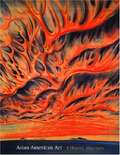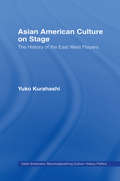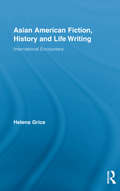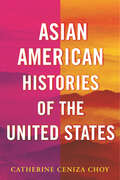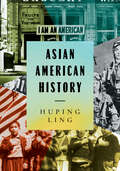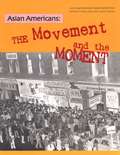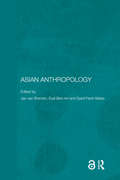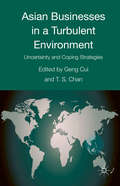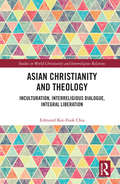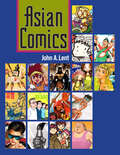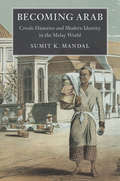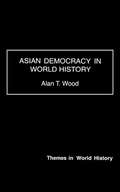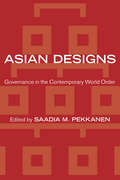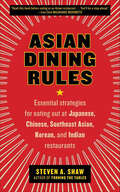- Table View
- List View
Asian America: A Primary Source Reader
by K. Scott Wong Cathy J. Schlund-Vials Jason Oliver ChangAn essential collection that brings together the core primary texts of the Asian American experience in one volume An essential volume for the growing academic discipline of Asian American studies, this collection of core primary texts draws from a wide range of fields, from law to visual culture to politics, covering key historical and cultural developments that enable students to engage directly with the Asian American experience over the past century. The primary sources, organized around keywords, often concern multiple hemispheres and movements, making this compendium valuable for a number of historical, ethnic, and cultural study undergraduate programs.
Asian America: A Primary Source Reader
by K. Scott Wong Cathy J. Schlund-Vials Jason Oliver ChangAn essential collection that brings together the core primary texts of the Asian American experience in one volume An essential volume for the growing academic discipline of Asian American studies, this collection of core primary texts draws from a wide range of fields, from law to visual culture to politics, covering key historical and cultural developments that enable students to engage directly with the Asian American experience over the past century. The primary sources, organized around keywords, often concern multiple hemispheres and movements, making this compendium valuable for a number of historical, ethnic, and cultural study undergraduate programs.
Asian American Art: A History, 1850-1970
by Mark Johnson Gordon H. Chang Paul KarlstromAsian American Art: A History, 1850-1970 is the first comprehensive study of the lives and artistic production of artists of Asian ancestry active in the United States before 1970. The publication features original essays by ten leading scholars, biographies of more than 150 artists, and over 400 reproductions of artwork, ephemera, and images of the artists. <p><p> Aside from a few artists such as Dong Kingman, Yasuo Kuniyoshi, Isamu Noguchi, and Yun Gee, artists of Asian ancestry have received inadequate historical attention, even though many of them received wide critical acclaim during their productive years. This pioneering work recovers the extraordinarily impressive artistic production of numerous Asian Americans, and offers richly informed interpretations of a long-neglected art history. To unravel the complexity of Asian American art expression and its vital place in American art, the texts consider aesthetics, the social structures of art production and criticism, and national and international historical contexts. <p><p> Without a doubt, Asian American Art will profoundly influence our understanding of the history of art in America and the Asian American experience for years to come.
Asian American Chronology: Chronologies Of The American Mosaic
by Xiaojian ZhaoFrom Filipino labor strikes to Japanese baseball players in the major leagues, this accessible volume presents the most influential events in Asian American history--as well as several key moments that have remained under the historical radar.
Asian American Culture on Stage: The History of the East West Players (Studies in Asian Americans)
by Yuko KurahashiThis book captures the 30-year history of the East West Players (EWP), tracing the company's representation of Asian Americans through the complex social and cultural changes of the past three decades.
Asian American Fiction, History and Life Writing: International Encounters (Routledge Transnational Perspectives On American Literature Ser. #10)
by Helena GriceThe last ten years have witnessed an enormous growth in American interest in Asia and Asian/American history. In particular, a set of key Asian historical moments have recently become the subject of intense American cultural scrutiny, namely China’s Cultural Revolution and its aftermath; the Korean American war and its legacy; the era of Japanese geisha culture and its subsequent decline; and China’s one-child policy and the rise of transracial, international adoption in its wake. Grice examines and accounts for this cultural and literary preoccupation, exploring the corresponding historical-political situations that have both circumscribed and enabled greater cultural and political contact between Asia and America.
Asian American Histories of the United States (REVISIONING HISTORY)
by Catherine Ceniza ChoyAn inclusive and landmark history, emphasizing how essential Asian American experiences are to any understanding of US historyOriginal and expansive, Asian American Histories of the United States is a nearly 200-year history of Asian migration, labor, and community formation in the US. Reckoning with the onset of the COVID-19 pandemic and the surge in anti-Asian hate and violence, award-winning historian Catherine Ceniza Choy presents an urgent social history of the fastest growing group of Americans. The book features the lived experiences and diverse voices of immigrants, refugees, US-born Asian Americans, multiracial Americans, and workers from industries spanning agriculture to healthcare.Despite significant Asian American breakthroughs in American politics, arts, and popular culture in the 21st century, a profound lack of understanding of Asian American history permeates American culture. Choy traces how anti-Asian violence and its intersection with misogyny and other forms of hatred, the erasure of Asian American experiences and contributions, and Asian American resistance to what has been omitted are prominent themes in Asian American history. This ambitious book is fundamental to understanding the American experience and its existential crises of the early 21st century.
Asian American History: An Encyclopedia (Asian American Studies Today)
by Huping LingA comprehensive survey, Asian American History places Asian immigration to America in international and domestic contexts, and explores the significant elements that define Asian America: imperialism and global capitalist expansion, labor and capital, race and ethnicity, immigration and exclusion, family and work, community and gender roles, assimilation and multiculturalism, panethnicity and identity, transnationalism and globalization, and new challenges and opportunities. It is an up-to-date and easily accessible resource for high school and college students, as well as anyone who is interested in Asian American history. Asian American History: Covers the major and minor Asian American ethnic groups. It presents the myriad and poignant stories of a diverse body of Asian Americans, from illiterate immigrants to influential individuals, within a broad and comparative framework, offering microscopic narratives as well as macroscopic analysis and overviews. Utilizes both primary and secondary sources, employs data and surveys, and incorporates most recent scholarly discourses. Attractive and accessible by incorporating voices and illustrations of the contemporaries and by using straightforward language and concise syntax, while maintaining a reasonable level of scholarly depth. Special features: Each chapter features Significant Events, Sidebars incorporating primary sources or scholarly debates, Review Questions, and Further Readings to aid and enhance student learning experience. Bibliographies, charts, maps, photographs and tables are included. Written by a preeminent historian with four decades of teaching, research, and publishing experiences in Asian American history, it is the best book on the subject to date.
Asian American Racialization and the Politics of U.S. Education (Critical Social Thought)
by Wayne AuAsian American Racialization and the Politics of U.S. Education explores issues surrounding Asian American education in the United States, and how they relate to educational theory, policy, and practice.The book challenges stereotypes and assumptions that pervade U.S. education, restores absent histories of Asian American people in this context, and provides concrete examples of educational actions and policies that enable anti-racist educational work to go on. It argues that understanding Asian American racialization in the U.S. is essential to fighting white supremacy in schools and communities.Utilizing frameworks from Asian American Studies and Cultural Studies, this book will be important reading for those interested in doing anti-racist, liberatory, and abolitionist educational work. In particular, it will be relevant for those working or researching in the fields of Asian American Education, Multicultural Education, Social Justice Education, and Critical Education.
Asian American War Stories: Trauma and Healing in Contemporary Asian American Literature (Routledge Research in American Literature and Culture)
by Jeffrey Tyler GibbonsAsian American War Stories examines contemporary Asian American literature that considers both the short-term and the long-term effects of war, trauma, and displacement on civilians, as well as the ways that individuals seek healing in the face of suffering. Through the works of contemporary writers like Chang-rae Lee, Ocean Vuong, Nora Okja Keller, Julie Otsuka, Lan Cao, and Lawson Inada, this book explores the ways that recent Asian American literature reflects the enduring consequences of America’s wars in Asia at the individual and collective levels. The book also considers the journeys that individuals take as they pursue healing of their traumatic wounds.
Asian Americans and the Mass Media: A Content Analysis of Twenty United States Newspapers and a Survey of Asian American Journalists (Studies in Asian Americans)
by Virginia Mansfield-RichardsonFirst published in 2000. Routledge is an imprint of Taylor & Francis, an informa company.
Asian Americans and the Shifting Politics of Race: The Dismantling of Affirmative Action at an Elite Public High School (Studies in Asian Americans)
by Rowena RoblesAsian Americans and the Shifting Politics of Race examines the political and discursive struggles around the dismantling of race-based admissions policies in an elite public high school in San Francisco. The book analyzes the arguments put forth by plaintiffs in and the media's depiction of the case, Brian Ho, Patrick Wong, & Hilary Chen v. SFUSD. The Ho lawsuit, filed by a group of Chinese Americans, challenged race-based admissions policies that were intended to ensure diversity by giving special consideration to African-American and Latino students. Robles argues that the Ho plaintiffs exploited the dominant racial construction of Asian Americans as model minorities to portray themselves as victims of discrimination, and relied on contrasting constructions of Black and Latino students as undeserving and unqualified beneficiaries of affirmative action. The decision in favor of the plaintiffs effectively ended school desegregation, racial balance, and affirmative action in San Francisco. In order to examine the consequences of the Ho decision on student attitudes, Robles spent four years studying and observing the first cohort of students to enter the high school after race was eliminated from admissions considerations.
Asian Americans in Dixie: Race and Migration in the South
by Khyati Y. Joshi Jigna DesaiExtending the understanding of race and ethnicity in the South beyond the prism of black-white relations, this interdisciplinary collection explores the growth, impact, and significance of rapidly growing Asian American populations in the American South. Avoiding the usual focus on the East and West Coasts, several essays attend to the nuanced ways in which Asian Americans negotiate the dominant black and white racial binary, while others provoke readers to reconsider the supposed cultural isolation of the region, reintroducing the South within a historical web of global networks across the Caribbean, Pacific, and Atlantic. Contributors are Vivek Bald, Leslie Bow, Amy Brandzel, Daniel Bronstein, Jigna Desai, Jennifer Ho, Khyati Y. Joshi, ChangHwan Kim, Marguerite Nguyen, Purvi Shah, Arthur Sakamoto, Jasmine Tang, Isao Takei, and Roy Vu.
Asian Americans in Michigan: Voices from the Midwest (Great Lakes Books Series)
by Sook Wilkinson Victor JewWhile the number of Asians in Michigan was small for a good portion of the state's history, many Asian-derived communities have settled in the area and grown significantly over time. In Asian Americans in Michigan: Voices from the Midwest, editors Sook Wilkinson and Victor Jew have assembled forty-one contributors to give an intimate glimpse into Michigan's Asian-American communities, creating a fuller picture of these often overlooked groups. Accounts in the collection come from a range of perspectives, including first-generation immigrants, those born in the United States, and third- and fourth-generation Americans of Asian heritage. In five sections, contributors consider the historical and demographic origins of Michigan's Asian American communities, explore their experiences in memory and legacy keeping, highlight particular aspects of community culture and heritage, and comment on prospects and hopes for the future. This volume's vibrant mix of contributors trace their ancestries back to East Asia (China, Japan, Korea, Taiwan), South Asia (Bangladesh, India, Pakistan), and Southeast Asia (Cambodia, Laos, Philippines, Thailand, Vietnam, and the Hmong). Though each contributor writes from his or her unique set of experiences, Asian Americans in Michigan also reveals universal values and memories held by larger communities. Asian Americans in Michigan makes clear the significant contributions by individuals in many fields--including art, business, education, religion, sports, medicine, and politics--and demonstrates the central role of community organizations in bringing ethnic groups together and preserving memories. Readers interested in Michigan history, sociology, and Asian American studies will enjoy this volume.
Asian Americans: The Movement And The Moment
by Steven Louie Glenn OmatsuCultural Writing. Asian American Studies. A wide-ranging collection of essays and material which documents the rich, little-known history of Asian American social activism during the years 1965-2001. This book examines the period not only through personal accounts and historical analysis, but through the visual record--utilizing historical prictorial materials developed at UCLA's Asian American Studies Center on Chinese, Japanese, Korean, Filipino, and Vietnamese Americans. Included are many reproductions of photos of the period, movement comics, demonstration flyers, newsletters, posters and much more.
Asian Anthropology (Anthropology of Asia)
by Syed Farid Alatas Eyal Ben-Ari Jan Van BremenAsian Anthropology raises important questions regarding the nature of anthropology and particularly the production and consumption of anthropological knowledge in Asia. Instead of assuming a universal standard or trajectory for the development of anthropology in Asia, the contributors to this volume begin with the appropriate premise that anthropologies in different Asian countries have developed and continue to develop according to their own internal dynamics. With chapters written by an international group of experts in the field, Asian Anthropology will be a useful teaching tool and a valuable resource for scholars working in Asian anthropology.
Asian Businesses in a Turbulent Environment: Uncertainty and Coping Strategies (AIB Southeast Asia)
by Geng Cui T. S. ChanAsian economies today command much attention from scholars and practitioners, yet they continue to face crises and challenges such as globalization, regional conflict, pressure for greater transparency and environmental protection to name but a few. Asian Businesses in a Turbulent Environment explores how Asian firms cope with these challenges, and the impact that rising above them will have on their growth prospects. Starting with a conceptual analysis of crises and their impact on local markets and societies, this book examines leadership styles for conflict management, as well as strategies adopted by various Asian firms including the location choice and entry mode, knowledge transfer, cultural shifts, social capital and knowledge development, and environmental management in the supply chain.
Asian Christianity and Theology: Inculturation, Interreligious Dialogue, Integral Liberation (Studies in World Christianity and Interreligious Relations)
by Edmund Kee-Fook ChiaThis book provides a comprehensive exploration of Asian Christianity and Theology, with emphasis on how it has developed in different parts of the continent and in the different eras, especially since the end of colonialism in Asia. Asian Theology refers to a unique way of theological reflection characterized by specific methodologies that evolved in postcolonial Asia. Premised on the thinking of Asian Church leaders and scholars, its focus is on the dialogue with the many cultures (inculturation), many religions (interreligious dialogue), and many poor (integral liberation) of Asia. The book looks at each of these ministries in detail, foregrounding Asian biblical hermeneutics, Christianity’s engagement with Hinduism, Confucianism, and Islam, Asian Women’s Theology, and the rise of Pentecostalism. The volume is valuable reading for scholars of religious studies, theology, world Christianity, Asian religions, and Asian studies.
Asian Comics
by John A. LentGrand in its scope, Asian Comics dispels the myth that, outside of Japan, the continent is nearly devoid of comic strips and comic books. Relying on his fifty years of Asian mass communication and comic art research, during which he traveled to Asia at least seventy-eight times and visited many studios and workplaces, John A. Lent shows that nearly every country had a golden age of cartooning and has experienced a recent rejuvenation of the art form. As only Japanese comics output has received close and by now voluminous scrutiny, Asian Comics tells the story of the major comics creators outside of Japan. Lent covers the nations and regions of Bangladesh, Cambodia, China, Hong Kong, India, Indonesia, Korea, Malaysia, Myanmar, Nepal, the Philippines, Singapore, Sri Lanka, Taiwan, Thailand, and Vietnam. Organized by regions of East, Southeast, and South Asia, Asian Comics provides 178 black-and-white illustrations and detailed information on comics of sixteen countries and regions—their histories, key creators, characters, contemporary status, problems, trends, and issues. One chapter harkens back to predecessors of comics in Asia, describing scrolls, paintings, books, and puppetry with humorous tinges, primarily in China, India, Indonesia, and Japan. The first overview of Asian comic books and magazines (both mainstream and alternative), graphic novels, newspaper comic strips and gag panels, plus cartoon/humor magazines, Asian Comics brims with facts, fascinating anecdotes, and interview quotes from many pioneering masters, as well as younger artists.
Asian Connections: Creole Histories and Modern Identity in the Malay World (Asian Connections)
by Mandal Sumit K.Sumit K. Mandal uncovers the hybridity and transregional connections underlying modern Asian identities. By considering Arabs in the Malay world under European rule, Becoming Arab explores how a long history of inter-Asian interaction was altered by nineteenth-century racial categorisation and control. Mandal traces the transformation of Arabs from familiar and multi-faceted creole personages of Malay courts into alienated figures defined by economic and political function. The racialisation constrained but did not eliminate the fluid character of Arabness. Creole Arabs responded to the constraints by initiating transregional links with the Ottoman Empire and establishing modern social organisations, schools, and a press. Contentions emerged between organisations respectively based on Prophetic descent and egalitarianism, advancing empowering but conflicting representations of a modern Arab and Islamic identity. Mandal unsettles finite understandings of race and identity by demonstrating not only the incremental development of a modern identity, but the contested state of its birth.
Asian Connections: Early Modern China and Northeast Asia
by Evelyn S. RawskiIn this revisionist history of early modern China, Evelyn Rawski challenges the notion of Chinese history as a linear narrative of dynasties dominated by the Central Plains and Hans Chinese culture from a unique, peripheral perspective. Rawski argues that China has been shaped by its relations with Japan, Korea, the Jurchen/Manchu and Mongol States, and must therefore be viewed both within the context of a regional framework, and as part of a global maritime network of trade. Drawing on a rich variety of Japanese, Korean, Manchu and Chinese archival sources, Rawski analyses the conflicts and regime changes that accompanied the region's integration into the world economy during the sixteenth and seventeenth centuries. Early Modern China and Northeast Asia places Sino-Korean and Sino-Japanese relations within the context of northeast Asian geopolitics, surveying complex relations which continue to this day.
Asian Connections: Law and Economic Life in the Western Indian Ocean, 1780–1950 (Asian Connections)
by Bishara Fahad AhmadIn this innovative legal history of economic life in the Western Indian Ocean, Bishara examines the transformations of Islamic law and Islamicate commercial practices during the emergence of modern capitalism in the region. In this time of expanding commercial activity, a m#65533;lange of Arab, Indian, Swahili and Baloch merchants, planters, jurists, judges, soldiers and seamen forged the frontiers of a shared world. The interlinked worlds of trade and politics that these actors created, the shared commercial grammars and institutions that they developed and the spatial and socio-economic mobilities they engaged in endured until at least the middle of the twentieth century. This major study examines the Indian Ocean from Oman to India and East Africa over an extended period of time, drawing together the histories of commerce, law and empire in a sophisticated, original and richly textured history of capitalism in the Islamic world.
Asian Democracy in World History (Themes in World History)
by Alan T. WoodTaking a comparative approach, Alan T. Wood traces the evolution of democracy from its origins in prehistoric times and describes democratic growth in thirteen Asian countries from Japan in East Asia to Pakistan in South Asia and examines key issues such as: * How does the democratic experience in Asia, in countries with unique and totalitarian political traditions, compare with democracies worldwide?* Is the aspiration to freedom universal or is it a product of western ideas and institutions?
Asian Designs: Governance in the Contemporary World Order
by Saadia PekkanenAsian nations are no longer "rising" powers in the world order; they have risen. How will they conduct themselves in world politics? How will they deploy their considerable and growing power individually and collectively? These questions are critical for global governance. Conventional wisdom claims that, lacking in institutions that accumulate and coordinate the massive economic and growing military strength of Asian nations, the Asian region will continue to punch below its weight in world politics; thin and patchy institutionalization results in political weakness. In Asian Designs, Saadia M. Pekkanen and her collaborators question and provide evidence on these core assumptions of Western scholarship. The book advances a new framework for debate and sophisticated examinations of institutional arrangements for several major issue areas in the world order—security, trade, environment, and public health.ContributorsVinod K. Aggarwal, University of California at BerkeleyC. Randall Henning, American University Keisuke Iida, University of TokyoPurnendra Jain, University of AdelaideDavid Kang, University of Southern California Saori N. Katada, University of Southern CaliforniaMin Gyo Koo, Seoul National UniversityKerstin Lukner, University of Duisburg-EssenTakamichi Tam Mito, Kwansei Gakuin UniversityJames Clay Moltz, Naval Postgraduate SchoolSaadia M. Pekkanen, University of WashingtonKim DoHyang Reimann, Georgia State UniversityKellee S. Tsai, Hong Kong University of Science and TechnologyMing Wan, George Mason University
Asian Dining Rules: Essential Strategies for Eating Out at Japanese, Chinese, Southeast Asian, Korean, and Indian Restaurants
by Steven A. ShawMost Asian restaurants are really two restaurants: one where outsiders eat, and one where insiders dine. So how can you become an insider and take full advantage of Asian cuisines? In this indispensable guide, dining expert Steven A. Shaw proves that you don't have to be Asian to enjoy a VIP experience—you just have to eat like you are. Through entertaining and richly told anecdotes and essays, Asian Dining Rules takes you on a tour of Asian restaurants in North America, explaining the cultural and historical background of each cuisine—Japanese, Chinese, Southeast Asian, Korean, and Indian—and offering an in-depth survey of these often daunting foodways. Here are suggestions for getting the most out of a restaurant visit, including where to eat, how to interact with the staff, be treated like a regular, learn to eat outside the box, and order special off-menu dishes no matter your level of comfort or knowledge.Steven Shaw—intrepid reporter, impeccable tastemaker, and eater extraordinaire—is the perfect dining companion to accompany you on your journey to find the best Asian dining experience, every time.


